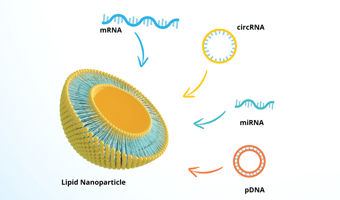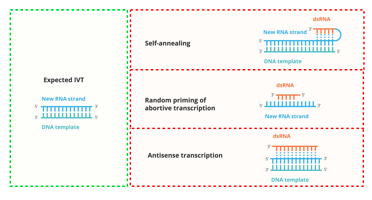RNA therapeutics represent a groundbreaking approach in modern medicine, leveraging RNA molecules...
RNA types and their role in RNA therapeutics
RNA-based medicines use RNA molecules to treat diseases by modulating gene expression, silencing harmful genes, or introducing therapeutic proteins. Unlike traditional drugs, which are often small molecules or antibodies that target only a small fraction (0.05%) of the human genome, RNA molecules can selectively interact with proteins, transcripts, and genes, expanding the range of druggable targets.
RNA therapeutics is a rapidly evolving field with the potential to revolutionize treatments for a wide variety of diseases, from genetic disorders to cancer. At the heart of these transformative therapies are various RNA types, each with distinct properties that make them suitable for different therapeutic applications.
In this section, we will explore the primary RNA therapeutic types—mRNA, saRNA, siRNA, circRNA, miRNA, and tRNA—and their specific roles in RNA-based treatments.
RNA types featured in scientific publications
RNA therapeutics encompass a broad range of RNA species. The main types of RNA studied include messenger RNA (mRNA), self-amplifying RNA (saRNA), small interfering RNA (siRNA), circular RNA (circRNA), microRNA (miRNA), and transfer RNA (tRNA). The following overview presents the percentage of published scientific papers focused on each RNA type within RNA research.

Overview of RNA types studied in RNA therapeutics, highlighting the dominance of mRNA (50.3%), followed by miRNA (27.1%) and other RNA types in smaller proportions in 2024 [Source: PubMed, 2025].
RNA types and their advantages in RNA therapeutics
Messenger RNA (mRNA)
mRNAs have become one of the most widely studied RNA types, particularly due to their role in COVID-19 vaccines. The primary advantage of mRNAs is their ability to encode a gene of interest, which can then be translated into protein once delivered to the cells. This makes it an ideal candidate for protein replacement therapies, vaccines, and gene editing applications.
Some benefits include:
-
High therapeutic potential: mRNA can encode for therapeutic proteins, making it highly versatile in treating genetic diseases, cancer, and infectious diseases.
-
Ease of synthesis: mRNA can be synthetically produced in vitro, enabling rapid development and scalability for various applications.
-
Transient expression: mRNA delivers its payload temporarily, which reduces the risk of unintended, long-term effects, especially for gene therapies.
Self-amplifying RNA (saRNA)
saRNAs build on mRNA by incorporating a viral replication system that allows for the amplification of the RNA within the target cells. This amplifying effect provides a greater therapeutic dose from a smaller amount of RNA, which can be beneficial for vaccines or long-term treatments.
Key advantages include:
-
Enhanced expression: saRNA can generate higher protein expression levels compared to standard mRNA, making it more efficient in eliciting a therapeutic response.
-
Reduced dosage requirements: Because of its self-amplifying nature, saRNA can be delivered at lower doses, reducing potential side effects.
-
Longer duration of action: The replication of saRNA in cells can lead to a sustained therapeutic effect, which may be important for chronic conditions or vaccines.
Small Interfering RNA (siRNA)
siRNAs are exogenous double-stranded RNA molecules that specifically target and silence a single mRNA sequence by promoting its degradation. siRNAs are usually highly specific in their action, targeting a single, specific mRNA transcript. This makes siRNA an excellent choice for therapeutic targeting, for example, fighting infections.
Benefits of siRNA include:
-
Precise gene silencing: siRNA can specifically silence genes with high precision, providing a mechanism for addressing diseases caused by overactive or mutated genes.
-
Targeted approach: siRNA can be designed to target a wide range of specific genes, allowing for personalized treatment options.
-
Reduced off-target effects: When designed carefully, siRNA can minimize the risk of affecting non-target genes, leading to more focused therapeutic interventions.
MicroRNA (miRNA)
miRNAs are endogenous short, single-stranded RNA that typically bind to the 3’ untranslated region (UTR) of target mRNA transcripts, leading to translational repression or mRNA degradation. Unlike siRNA, miRNA usually targets multiple mRNAs, regulating entire networks of genes. This makes them suitable for gene regulation, disease modulation, or cancer therapy.
Advantages of miRNA in therapeutics include:
-
Multiple genes regulation: miRNAs typically regulate the expression of multiple genes, which makes them valuable for addressing diseases with complex genetic underpinnings.
-
Endogenous pathways: Since miRNAs are part of the body’s natural gene-regulatory processes, they are well-tolerated and less likely to provoke an immune response when used therapeutically.
-
Modulate gene expression: miRNAs can be used to either suppress or enhance gene expression, which can be therapeutic for diseases like cancer and heart disease.
Circular RNA (circRNA)
Circular RNA (circRNA) is a naturally occurring class of RNA that forms a covalently closed loop, making it highly stable. This unique structure offers several advantages, particularly in gene regulation or protein replacement.
Advantages of leveraging circRNA:
-
Increased Stability: CircRNA is less susceptible to degradation by exonucleases compared to linear RNA, providing more stability in circulation and longer-lasting therapeutic effects.
-
Gene Regulation: CircRNA can act as a sponge to absorb microRNAs, which can regulate gene expression and play a role in disease-modifying therapies.
-
Potential for New Therapeutic Approaches: Certain circRNAs can be translated into small peptides. These peptides can perform a variety of functions, such as protein replacement or CAR-T therapy.
Transfer RNA (tRNA)
Transfer RNA (tRNA) plays a key role in translating the genetic code from mRNA into protein by delivering amino acids to the ribosome. While traditionally not used in therapeutics, its potential is being explored for applications in gene editing and protein synthesis. Benefits of tRNA include:
-
Protein Translation: By using synthetic tRNAs that are optimized for specific codons, researchers can enhance the efficiency of protein translation. This can be particularly useful in therapies that involve mRNA-based vaccines or protein replacement, as optimized tRNAs can increase protein yield.
-
Gene Editing Applications: tRNA is being studied as a potential component of RNA-based gene editing systems, enhancing the precision and efficiency of tools like CRISPR-Cas9.
-
Amino Acid Supplementation: tRNA molecules could be designed to deliver specific amino acids that are deficient or dysregulated in certain diseases, supporting targeted therapeutic applications.
Next step? RNA-LNP
Lipid Nanoparticles (LNPs) have emerged as an efficient and safer vehicle for RNA therapeutics. See our RNA-LNP platform or contact us for a consultation on RNA-LNP.
Why partner with CATUG RNA Biotechnology?


